Dirt Contractors Lafayette
Top 10 Dirt Hauling in Lafayette
Receive 3 FREE Dirt Contractors quotes for your project today! Compare profiles, reviews, accreditations, portfolio, etc... and choose the best service.

Pickett Industries Inc
3.912 reviewsPickett Industries, LLC corporate office, Bossier City, Louisiana, USPickett Industries: A Legacy of Environmental Management and Heavy Civil Construction Pickett Industries has been a trusted name in the Southeast for over seventy years, providing comprehensive environmental management services and heavy civil construction solutions to corporations and government entities. Our commitment to excellence, safety, and environmental responsibility has earned us a reputation for delivering high-quality results on time and within budget. Our Mission Our mission is to provide our clients with the highest quality environmental management and heavy civil construction services, while maintaining a commitment to safety, environmental responsibility, and exceeding expectations. Our Values At Pickett Industries, we are guided by the following core values: Safety First Environmental Responsibility Customer Satisfaction Integrity Teamwork Our Experience Pickett Industries has a long and successful history of providing services to a wide range of industries, including: Pulp and Paper Power Plant Coal Mining Landfill General Services Our Team Our team of experienced professionals is dedicated to providing our clients with the highest quality services. We are committed to safety, environmental responsibility, and exceeding expectations.
- Services
- Why Us?
- Our Team
- Testimonials
- Gallery
Get Quote
J&M LandPros
510 reviewsNatchitoches, USJ&M LandPros: Your Trusted Partner for Dirt Work in Central LA and East TX J&M LandPros is a Natchitoches, LA Excavation company with a proven track record of success in the industry. We offer a wide range of services, including: Culvert installs Driveway construction and repair Custom pond construction New home site development Rock and dirt hauling And much more! We are one of the most respected construction companies in Natchitoches and Sabine Parish Areas, known for our commitment to quality and customer satisfaction. Specializing in Custom Ponds Looking to add value to your property and life? We are the go-to experts for custom family and fishing ponds. Tell us about your vision or goals, and we'll help you design a functional pond that meets your needs. Our pond excavation experience in central Louisiana has been serving local pond owners and property owners for several years. We understand the importance of having the right pond and ensure it's constructed properly to protect your investment. Pond Repair and Restoration If your pond has suffered damage from erosion due to construction equipment or flooding, we offer pond repair services in Toledo Bend, Zwolle, Many, Mansfield, Natchitoches, Leesville, Stonewall, Shreveport, and all surrounding areas, including East Texas. We'll restore the integrity of your pond quickly and prevent future costs associated with fallen pond walls. Comprehensive Land Clearing and Excavation Services Whether you need pond services in Sabine Parish or land clearing services in Natchitoches, J&M LandPros is your one-stop shop. We also handle gravel, dirt, rock, and sand hauling, trusted by locals in Sabine Parish, Desoto Parish, Vernon Parish, and Natchitoches Parish. Our land clearing and excavation services are available to both commercial and residential customers. We inspect and clear your property quickly and safely at a fair price. Let us know what we can do for you today! Driveway Construction and Repair When winter brings rain, snow, and ice, it's time for driveway repairs. J&M LandPros provides the ideal driveway construction and repair service in Many, LA. We'll ensure your driveway is safe and reliable all year round.
- Services
- Why Us?
- Gallery
Get Quote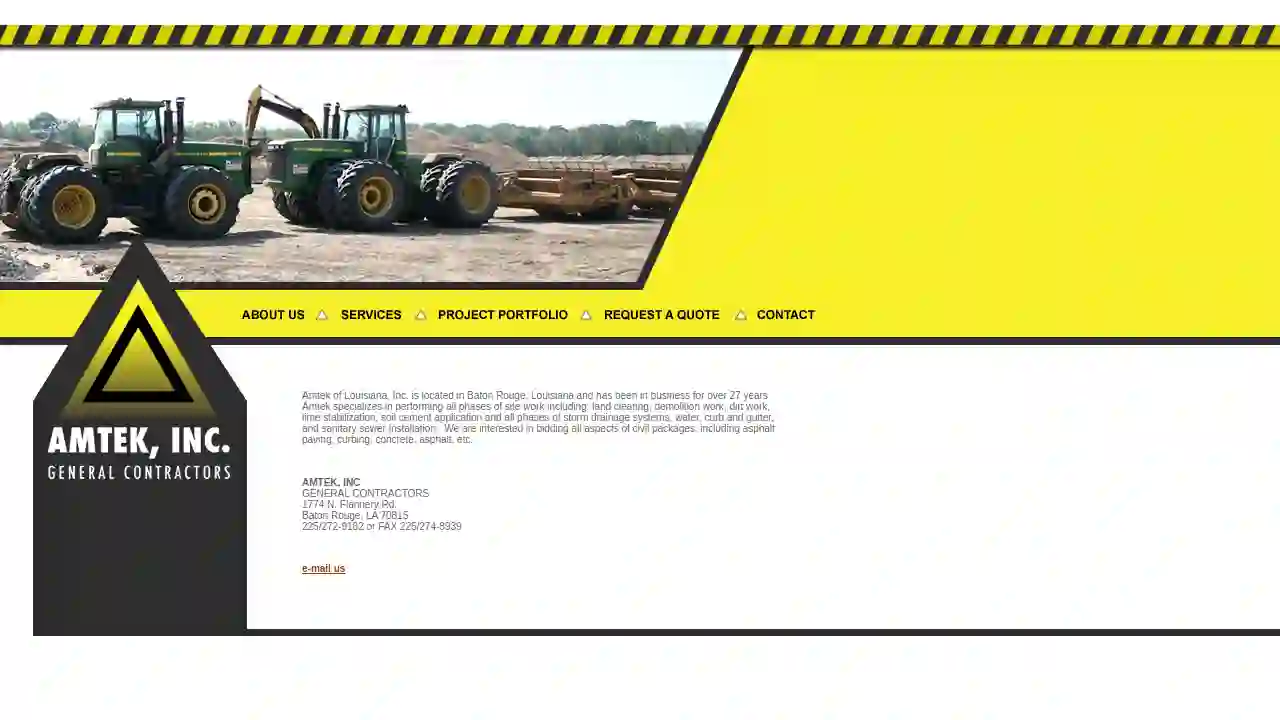
Amtek Inc
32 reviews1774 N. Flannery Rd., Baton Rouge, 70815, USAbout Amtek of Louisiana, Inc. Amtek of Louisiana, Inc. is a Baton Rouge, Louisiana-based company with over 27 years of experience in the construction industry. We specialize in all phases of site work, including land clearing, demolition, dirt work, lime stabilization, soil cement application, and storm drainage systems. We also handle water, curb and gutter, and sanitary sewer installation. We are committed to providing high-quality services and exceeding our clients' expectations. Our team of experienced professionals is dedicated to delivering projects on time and within budget. We are interested in bidding on all aspects of civil packages, including asphalt paving, curbing, concrete, and asphalt.
- Services
- Why Us?
- Gallery
Get Quote
The Baton Rouge Excavating Company
53 reviews123 Main Street, Baton Rouge, 70806, USExcavating Company Baton Rouge: Your Trusted Partner for Excavation Services At Excavating Company Baton Rouge, we are a team of experienced and dedicated professionals committed to providing top-notch excavation services to the Baton Rouge area. We understand the importance of precision, efficiency, and safety in every project, and we strive to deliver exceptional results that exceed your expectations. With years of experience in the industry, we have built a solid reputation for reliability, quality workmanship, and customer satisfaction. We are equipped with state-of-the-art equipment and a skilled workforce to handle any excavation project, big or small. Whether you need site preparation for a new construction project, utility trenching, foundation excavation, or any other excavation service, we have the expertise and resources to get the job done right. We are committed to working closely with our clients to understand their specific needs and deliver customized solutions that meet their unique requirements. Contact us today for a free consultation and let us help you bring your project to life.
- Services
- Why Us?
Get Quote
JR's Land Clearing, LLC
51 reviews123 Main St, Pearsville, 70581, USAbout Excavating Contractors Pearsville LA Excavating Contractors Pearsville LA is a locally owned and operated business serving the Pearsville, LA area. We are committed to providing our clients with high-quality excavation services at competitive prices. Our team of experienced professionals is dedicated to delivering exceptional results on every project, no matter how big or small. We understand that excavation projects can be complex and require a high level of expertise. That's why we use only the latest equipment and techniques to ensure that your project is completed on time and within budget. We also take pride in our commitment to safety and environmental responsibility. Whether you need site preparation, foundation excavation, utility installation, or any other excavation services, Excavating Contractors Pearsville LA is the company to call. Contact us today for a free consultation.
- Services
- Why Us?
Get Quote
Laborde Land Management
1Opelousas, La, 70570, La 70570, USLaborde Land Management is a premier land management company proudly serving Louisiana. Since our inception, we have embraced an approach to project management, delivering a broad spectrum of services to meet our clients’ diverse needs. Our expertise includes excavation, land clearing, grading, site preparation, and erosion control, ensuring that every aspect of your project is handled with precision and professionalism. Whether you are a homeowner looking to prepare your property for construction or a developer with large-scale land management needs, we have the experience and resources to bring your vision to life. At Laborde Land Management, we understand that each project is unique. That’s why we offer customized solutions tailored to your specific requirements. Our commitment to safety, efficiency, and customer satisfaction sets us apart in the industry. Contact us today to learn more about how we can assist you with your next project and to receive a free, no-obligation estimate. We look forward to partnering with you to achieve your land management goals.
- Services
- Why Us?
- Gallery
Get Quote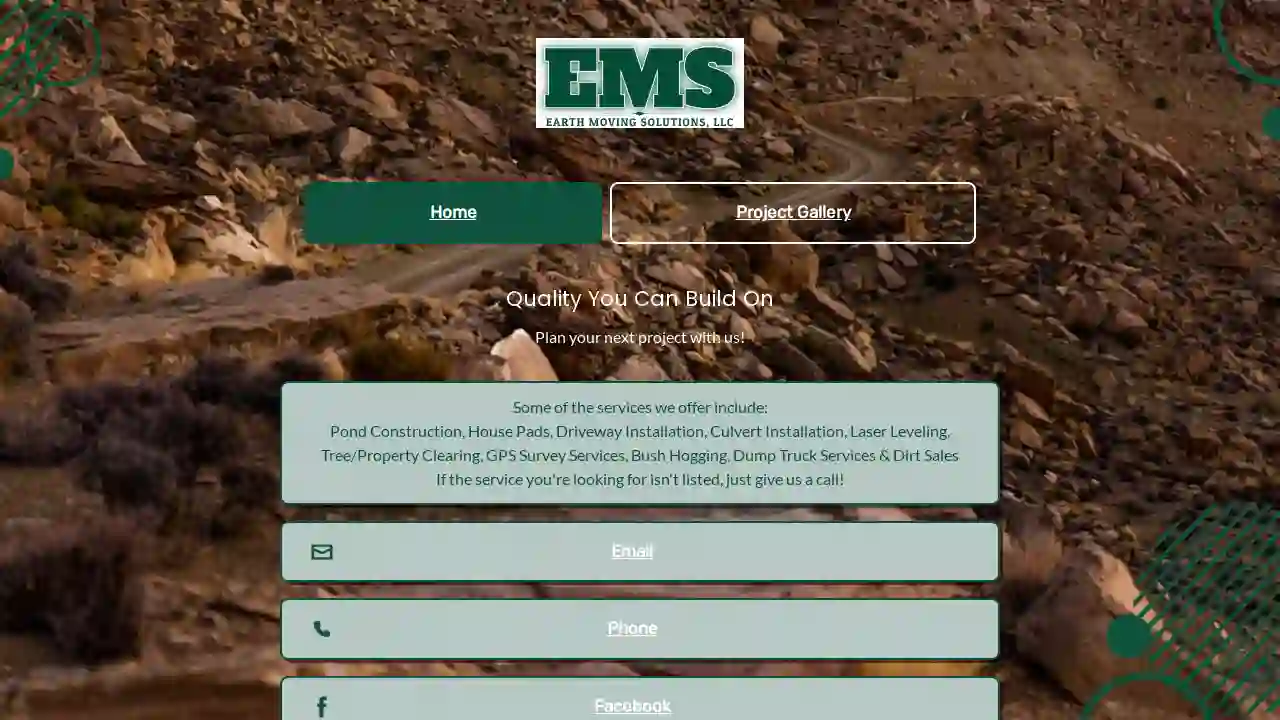
Earth Moving Solutions LLC
517 reviewsBaton Rouge, USQuality You Can Build On Plan your next project with us! We offer a wide range of services to meet your needs, including: Pond Construction House Pads Driveway Installation Culvert Installation Laser Leveling Tree/Property Clearing GPS Survey Services Bush Hogging Dump Truck Services Dirt Sales If the service you're looking for isn't listed, just give us a call!
- Services
- Why Us?
- Gallery
Get Quote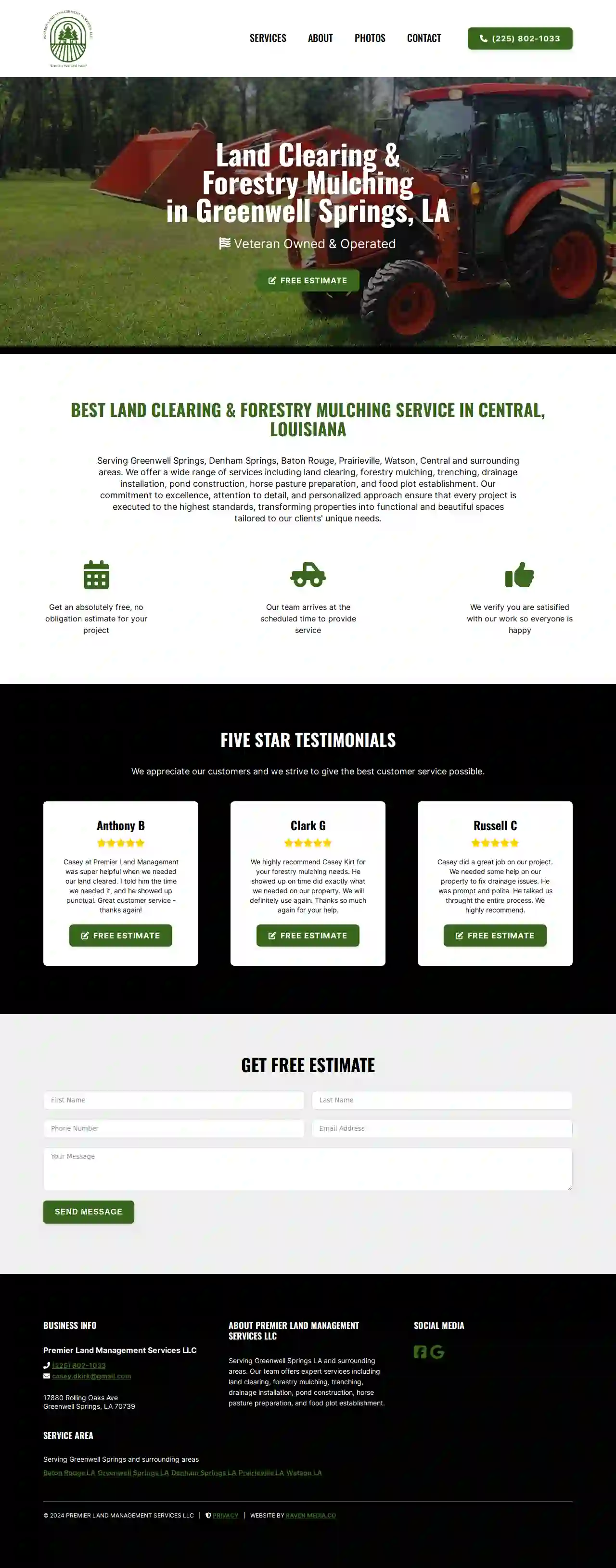
Premier Land Management Services LLC
57 reviews17880 Rolling Oaks Ave, Greenwell Springs, 70739, USAbout Premier Land Management Services LLC Premier Land Management Services LLC was founded by Casey Kirk with the goal of providing innovative solutions for homeowners and landowners in Central, Louisiana to reclaim and revitalize their properties. Casey started the company to help people transform their land into functional yet enjoyable spaces through expert land management services. Casey has over 20 years of construction experience and has a degree in Construction Management from Louisiana State University. At Premier Land Management Services, we understand that your land is a valuable asset, and proper management is crucial to unlock its full potential. Whether you need to clear land for residential or commercial development, establish a thriving equestrian facility, or create an inviting outdoor space, our team has the expertise and resources to turn your vision into reality. Our comprehensive range of services includes: Land Clearing: We utilize state-of-the-art equipment and techniques to clear your land safely and efficiently, preparing it for various purposes while minimizing environmental impact. Forestry Mulching: Our eco-friendly forestry mulching services grind and shred unwanted vegetation, leaving behind a protective mulch layer that enhances soil quality and suppresses weed growth. Trenching and Drainage: Our skilled team can expertly install underground utilities, drainage systems, and irrigation lines, ensuring proper water management and preventing erosion. Pond Construction: From scenic water features to functional irrigation ponds, we handle every aspect of pond construction, including site selection, excavation, lining, and aeration. Horse Pasture Preparation: We specialize in creating lush, nutrient-rich pastures tailored to the needs of horse owners and breeders, ensuring the health and well-being of their equine companions. Food Plots: Our food plot services are designed to enhance hunting experiences and promote biodiversity by establishing attractive and sustainable plots for wildlife. At Premier Land Management Services LLC, we pride ourselves on our commitment to excellence, attention to detail, and personalized approach to every project. Our team of dedicated professionals works closely with clients to understand their unique requirements and develop customized solutions that exceed their expectations. Contact us today to learn how we can help you reclaim and transform your property into a functional and enjoyable space.
- Services
- Why Us?
- Our Team
- Testimonials
- Gallery
Get Quote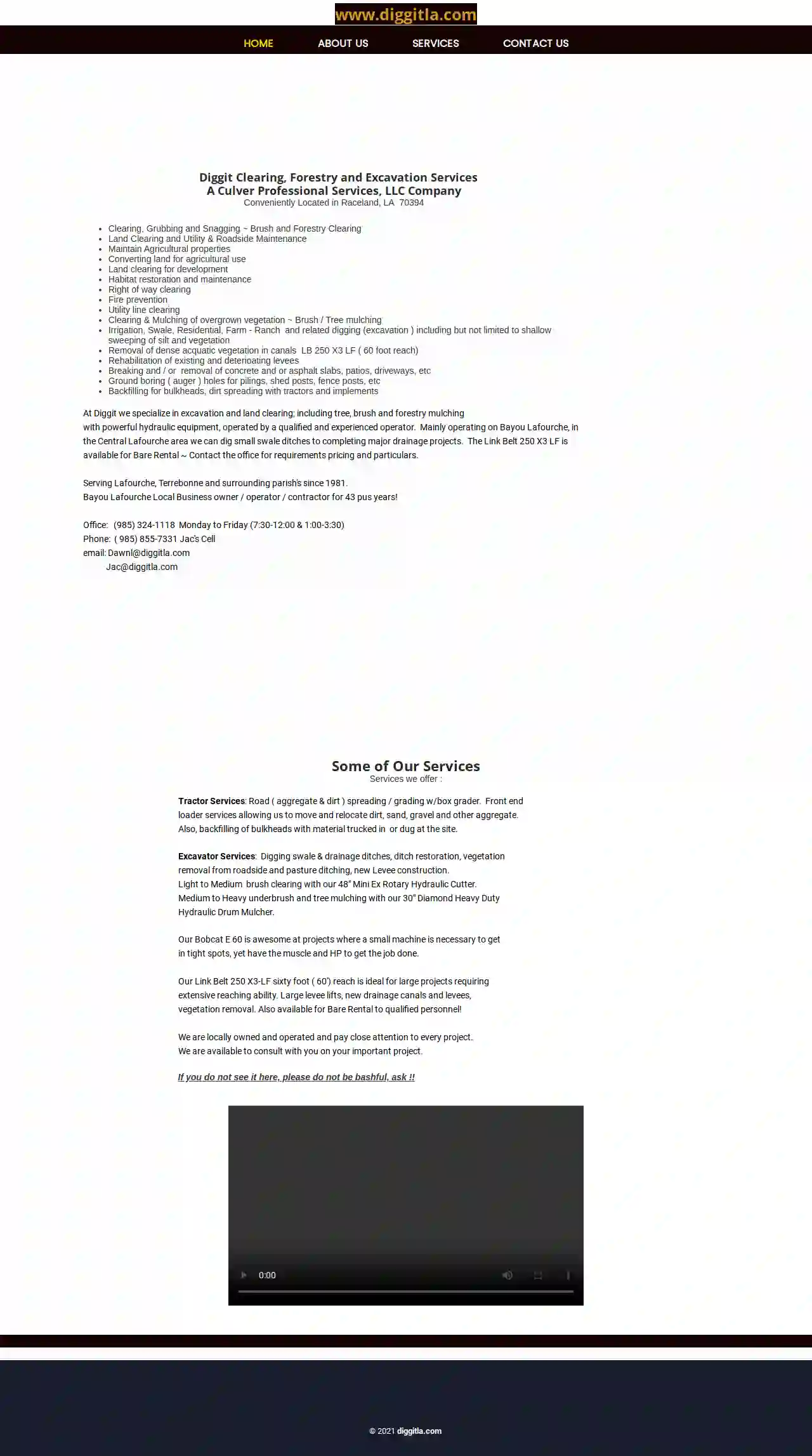
Diggit Clearing, Forestry and Excavation
1Baton Rouge, US- Services
- Why Us?
Get Quote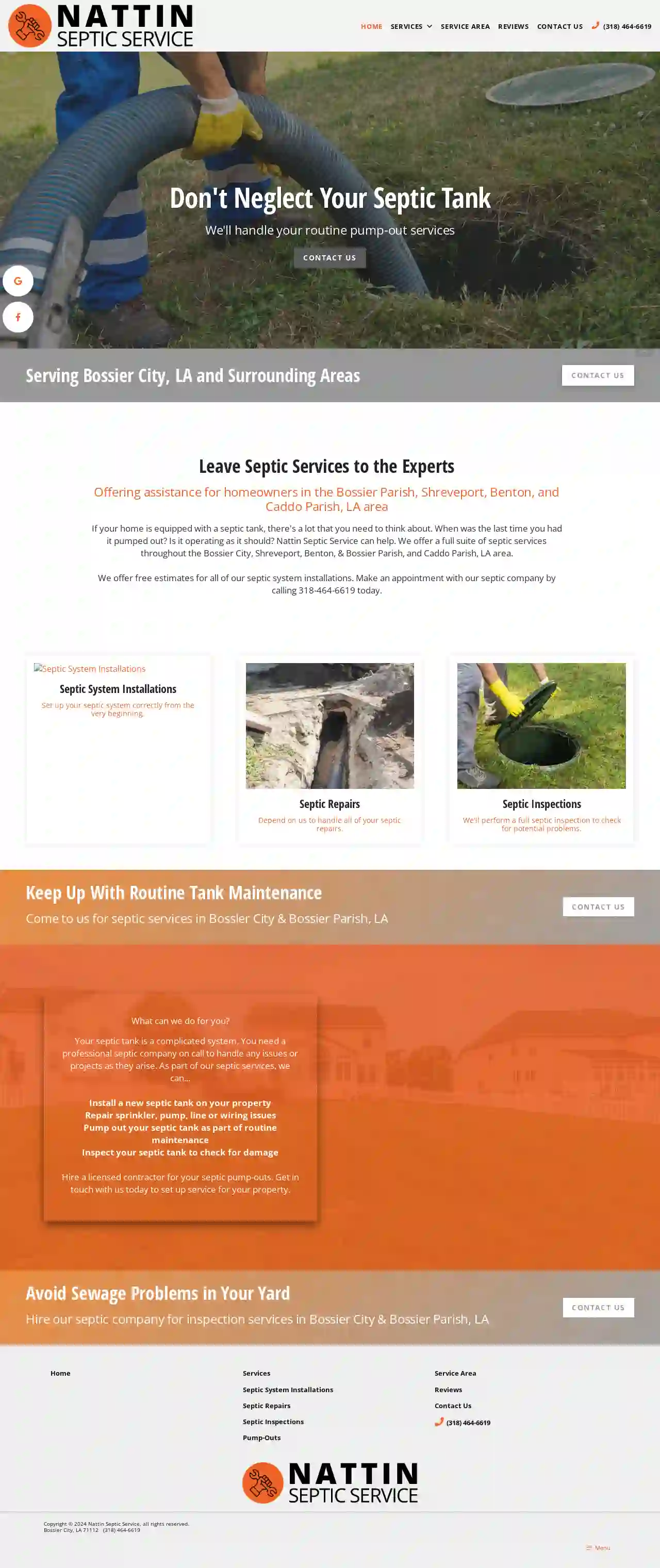
Nattin Septic Service
545 reviews1903 Mars Drive, Bossier City, 71112, USDon't Neglect Your Septic Tank We'll handle your routine pump-out services Serving Bossier City, LA and Surrounding Areas Offering assistance for homeowners in the Bossier Parish, Shreveport, Benton, and Caddo Parish, LA area Leave Septic Services to the Experts If your home is equipped with a septic tank, there's a lot that you need to think about. When was the last time you had it pumped out? Is it operating as it should? Nattin Septic Service can help. We offer a full suite of septic services throughout the Bossier City, Shreveport, Benton, & Bossier Parish, and Caddo Parish, LA area.We offer free estimates for all of our septic system installations. Make an appointment with our septic company by calling 318-464-6619 today. Septic System Installations Set up your septic system correctly from the very beginning. Septic Repairs Depend on us to handle all of your septic repairs. Septic Inspections We'll perform a full septic inspection to check for potential problems. Keep Up With Routine Tank Maintenance Come to us for septic services in Bossier City & Bossier Parish, LA What can we do for you? Your septic tank is a complicated system. You need a professional septic company on call to handle any issues or projects as they arise. As part of our septic services, we can...Install a new septic tank on your propertyRepair sprinkler, pump, line or wiring issuesPump out your septic tank as part of routine maintenanceInspect your septic tank to check for damageHire a licensed contractor for your septic pump-outs. Get in touch with us today to set up service for your property. Avoid Sewage Problems in Your Yard Hire our septic company for inspection services in Bossier City & Bossier Parish, LA
- Services
- Why Us?
- Testimonials
- Gallery
Get Quote
Over 3,943+ Excavation Companies registered
Our excavation pros operate in Lafayette & beyond!
ExcavationHQ has curated and vetted Top Excavation Companies near Lafayette. Find the most reliable pro today.
Frequently Asked Questions About Dirt Contractors
- Clearly Define Your Project Scope: Provide the contractor with detailed information about your project, including the size of the area, the type and volume of dirt needed, the desired grading or leveling, and any specific requirements.
- Obtain Multiple Quotes: Request quotes from multiple reputable dirt contractors to compare prices, services, and experience. Ensure the quotes are comprehensive and include all project details.
- Verify Licensing and Insurance: Confirm that the contractor has the necessary licenses, insurance coverage, and a good safety record. This protects you from potential liabilities.
- Communicate Openly and Regularly: Maintain open communication with the contractor throughout the project, addressing any questions, concerns, or changes promptly. Regular updates and site visits can help ensure everything is on track.
- Document Everything: Keep written records of all communication, contracts, quotes, and invoices for reference and accountability.
- Clear the Area: Remove any obstacles, such as furniture, toys, or landscaping features, from the designated delivery zone.
- Mark Utilities: Contact your local utility companies to have underground utilities, such as water lines, gas lines, or electrical cables, marked to prevent accidental damage during delivery.
- Protect Existing Landscaping: Cover or move any valuable plants, shrubs, or trees that might be affected by the dirt delivery.
- Provide Access: Ensure the delivery truck has clear access to the delivery zone, including wide enough gates or driveways.
- Communicate with the Contractor: Discuss any specific instructions or concerns you have with the dirt contractor before delivery day.
- Erosion Control: Implement measures to prevent soil erosion during and after excavation, grading, or dirt removal. This includes using silt fences, erosion control blankets, or planting vegetation to stabilize the soil.
- Soil Conservation: Preserve existing topsoil whenever possible, as it's a valuable resource for plant growth. Strip and stockpile topsoil separately for reuse in landscaping or gardening.
- Responsible Waste Management: Dispose of excess dirt, debris, and contaminated soil responsibly at designated facilities. Recycle materials whenever possible to reduce waste sent to landfills.
- Dust Control: Minimize dust generation during excavation and hauling by using water sprays, misting systems, or other dust suppression techniques.
- Noise Reduction: Use noise-reducing equipment and schedule noisy activities during permitted hours to minimize disturbance to neighbors and wildlife.
- Plant Selection: Understanding your soil's pH and nutrient levels helps you choose plants that will thrive in those conditions.
- Fertilizer Recommendations: Soil tests reveal nutrient deficiencies, allowing you to apply appropriate fertilizers to meet plant needs.
- Soil Amendments: Identify soil imbalances, such as compaction or high clay content, and recommend amendments to improve soil structure and drainage.
- Construction Projects: Assess soil bearing capacity and other properties to ensure the stability and safety of foundations and other structures.
- Environmental Assessments: Detect potential soil contamination and determine the need for remediation.
What are some tips for working with dirt contractors?
How do I prepare my yard for dirt delivery?
What are the environmental considerations for dirt contracting?
What is a soil test, and why is it important?
What are some tips for working with dirt contractors?
- Clearly Define Your Project Scope: Provide the contractor with detailed information about your project, including the size of the area, the type and volume of dirt needed, the desired grading or leveling, and any specific requirements.
- Obtain Multiple Quotes: Request quotes from multiple reputable dirt contractors to compare prices, services, and experience. Ensure the quotes are comprehensive and include all project details.
- Verify Licensing and Insurance: Confirm that the contractor has the necessary licenses, insurance coverage, and a good safety record. This protects you from potential liabilities.
- Communicate Openly and Regularly: Maintain open communication with the contractor throughout the project, addressing any questions, concerns, or changes promptly. Regular updates and site visits can help ensure everything is on track.
- Document Everything: Keep written records of all communication, contracts, quotes, and invoices for reference and accountability.
How do I prepare my yard for dirt delivery?
- Clear the Area: Remove any obstacles, such as furniture, toys, or landscaping features, from the designated delivery zone.
- Mark Utilities: Contact your local utility companies to have underground utilities, such as water lines, gas lines, or electrical cables, marked to prevent accidental damage during delivery.
- Protect Existing Landscaping: Cover or move any valuable plants, shrubs, or trees that might be affected by the dirt delivery.
- Provide Access: Ensure the delivery truck has clear access to the delivery zone, including wide enough gates or driveways.
- Communicate with the Contractor: Discuss any specific instructions or concerns you have with the dirt contractor before delivery day.
What are the environmental considerations for dirt contracting?
- Erosion Control: Implement measures to prevent soil erosion during and after excavation, grading, or dirt removal. This includes using silt fences, erosion control blankets, or planting vegetation to stabilize the soil.
- Soil Conservation: Preserve existing topsoil whenever possible, as it's a valuable resource for plant growth. Strip and stockpile topsoil separately for reuse in landscaping or gardening.
- Responsible Waste Management: Dispose of excess dirt, debris, and contaminated soil responsibly at designated facilities. Recycle materials whenever possible to reduce waste sent to landfills.
- Dust Control: Minimize dust generation during excavation and hauling by using water sprays, misting systems, or other dust suppression techniques.
- Noise Reduction: Use noise-reducing equipment and schedule noisy activities during permitted hours to minimize disturbance to neighbors and wildlife.
What is a soil test, and why is it important?
- Plant Selection: Understanding your soil's pH and nutrient levels helps you choose plants that will thrive in those conditions.
- Fertilizer Recommendations: Soil tests reveal nutrient deficiencies, allowing you to apply appropriate fertilizers to meet plant needs.
- Soil Amendments: Identify soil imbalances, such as compaction or high clay content, and recommend amendments to improve soil structure and drainage.
- Construction Projects: Assess soil bearing capacity and other properties to ensure the stability and safety of foundations and other structures.
- Environmental Assessments: Detect potential soil contamination and determine the need for remediation.